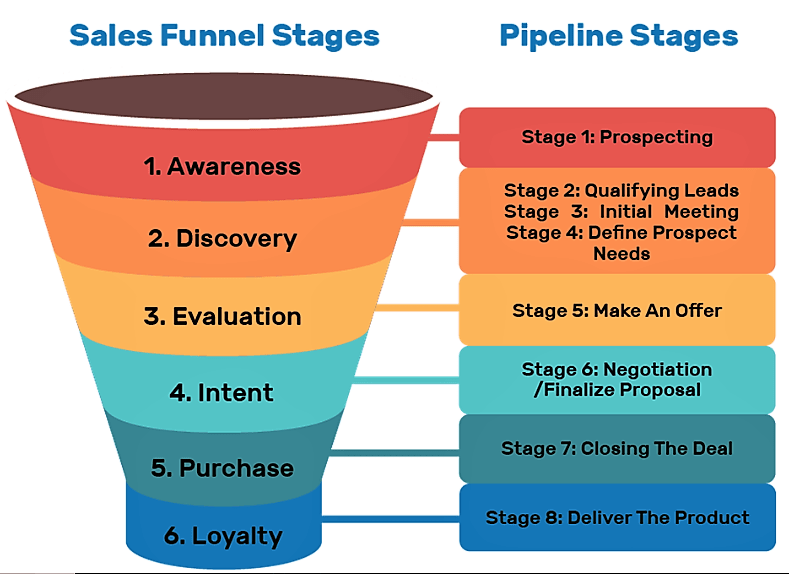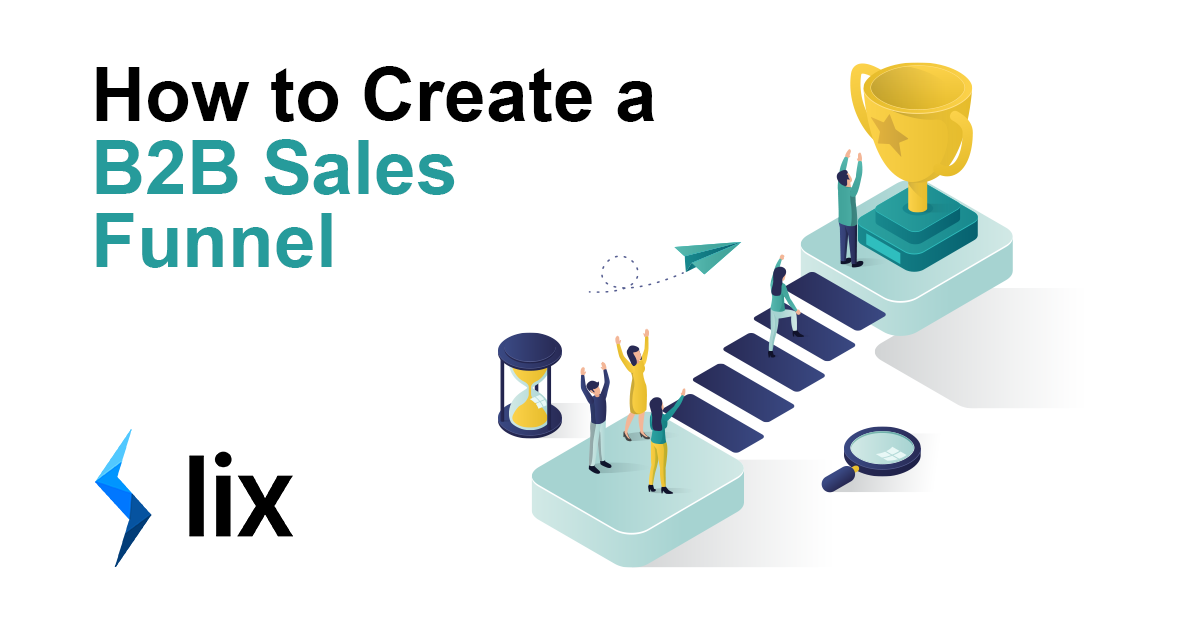A B2B sales funnel is a visual representation of the customer buying journey. It helps companies to understand their customers and how they progress through the sales process. A typical funnel starts at the top with the broadest audience, moves on to those who are interested in your business’s products or services, then narrows down further to qualified leads and finally, prospective customers.
Understand your funnel
- Know your funnel:
The first step to creating a B2B sales funnel is to understand what a funnel is in the first place. A B2B sales funnel is essentially a process that takes your prospects from being unaware of you or your product/service, through various stages until they become customers.
The shape of your B2B sales funnel will vary depending on how you want it to look and what steps your customers take. For some, it will be marketing-driven and heavy on content. For others, it’ll begin and end with the sales team doing outreach and closing deals. Here’s a typical sales funnel:

- Understand why your team needs one:
Funnels are useful because they allow marketers and salespeople to track their leads as they move through different stages of engagement with their brand or product/service. They also help organisations understand where there are opportunities for improvement. If you can figure out where your funnel has a leak, you focus on improving those specific areas. - Measure what matters most:
Having a funnel in place allows you to segment your data, with each stage of the funnel having its own metrics to track. In breaking your data down this way, you can identify which metrics matter most. Are the people who read your blogs most likely to convert? Best get more blogs out, or improve the reach of your current work. Do cold emails work better than calls? It’s time to ramp up your cold outreach!
Develop buyer personas
A buyer persona (also known as an Ideal Customer Profile) is a fictional character that represents your ideal customer. It helps you to understand your customer better, and it helps you create better content—from landing pages to sales pitches. If you’ve never created one before, it can be daunting at first, but the payoff is worth it.
You don’t have to wait until after the initial meeting or conversation with a prospect in order to get started on this process; developing buyer personas can help guide your conversations from the very beginning of any interaction with customers or clients.
With your persona in place, it’s time to start marketing (and selling!) to that persona…
Develop a content strategy
Content strategy is the process of planning, creating and distributing content. If content is part of your funnel, this is needs to become an essential component of your marketing plan.
The goal of a content strategy is to create a cohesive marketing message that resonates with your audience, increases brand awareness and drives conversions from prospects into paying customers.
Content strategy includes:
- Creating editorial calendars for video production, blog posts, articles, social media posts and more
- Defining which topics are most relevant to your business sector or industry – then creating content that addresses those topics in an engaging way that helps you connect with potential customers
Lead magnets can generate new leads
A lead magnet is an incentive offered to potential buyers in exchange for their contact information and/or email address. This can take the form of an ebook, webinar, or other valuable piece of content that you create specifically for your target market (and which they’re not likely to find elsewhere).
Lead magnets are nothing new, they have been around since the dawn of online marketing. By now, users now the deal – they’re aware of the fact that by signing up for your webinar, or downloading your eBook, they’re likely to be contacted. With so many companies contacting them daily, their guard is naturally up. You need to really offer demonstrable value in order to overcome this hurdle. A half-assed lead magnet will yield no results!
- Include incentives:
If you want your lead magnet to be effective, it needs to be attractive enough to encourage people who would otherwise ignore or delete it without a second thought. This means providing value through information that helps them solve problems they have and/or helps them save time or money in some way. While this can mean more than just creating something new from scratch—you could also repackage existing resources into something more appealing—it’s important not only that you make sure there are benefits but also that these benefits aren’t lost on readers because they’re buried under layers upon layers of fluff text or poorly-written copy (which will turn people off faster than any other mistake).
Find ways to distribute your content
Now that you’ve got your lead magnet or other content pieces ready, the next step is distribution. This is often easier said than done. If you already have popular marketing channels, like a great mailing list, high traffic blog or socials with great engagement – these are your first stop! If not, it’s time to get creative. Think about your ICP hang out, what spaces do they occupy and how can you best reach them? Advertising your lead magnet can sometimes be a good option, but be aware that you’re playing a long game with ROI.
Here are some common methods for content distribution:
- Email marketing
Whether your own mailing list, or one that you can get your content onto (either by paying for a slot, or perhaps exchanging a share for share with somebody) emails are a great way to distribute content. An engaged list, being sent relevant content, will reap rewards. - Cold email
Content can be a great way to open a cold email conversation with a prospect. Asking someone to read a blog, or watch a video, is often an easier ask than requesting a call back! Just be sure to follow the correct protocol for cold emailing and keep the content super relevant to the receiver. - Social media marketing ( including Facebook ads, Instagram ads etc)
If you’ve already got social channels with plenty of engagement – great! Those users are your first port of call for distribution. Those engaged brand-advocates will often share your content for you, plus their likes and comments boost your content via the social channel’s algorithm. It’s a win-win. If you don’t have social channels with enough traffic, you can opt for ads. My advice if you’re new to ads, is start small with experiments and then hone in on what works. - Search engine optimization (SEO) & link building:
This is a mammoth topic for me to sum up in a paragraph! If you’re reading this, you likely either know some SEO or have someone on your team that does. If not, great reading! SEO is the slowest option of those listed, but it is both free and powerful. Once you begin to rank for a term, you’ll reap rewards. The sooner you start, the better!
Send those leads down the funnel
This point is where the collaboration between sales and marketing becomes super important. There is no use in marketing filling the hopper with potential leads that never make it to the sales team – there’s also no use in sales team talking to unqualified leads from marketing.
It’s important that leads are nurtured through the process, hitting the correct steps and being gently pushed in the direction of a close. Here are three ways of doing that.
It’s important for sales and marketing to sit down together and decide at what point in the journey, leads are considered qualified. Everything up until that point, is marketing’s domain. It’s their responsibility to provide and deliver upon a strategy to nurture users down the funnel, to the point of qualification. Then, they’re passed to the sales team to begin the closing process. The steps required for each team to do their job will not be alien to either! Driving traffic and generating interest should be bread and butter to a b2b marketer, and closing is the driving force of sales. The funnel simply serves as a framework to join these forces together.
It’s never too soon to start working on your sales funnel.
It’s never too soon to start working on your B2B sales funnel. You can begin now by identifying the steps of your sales process, from prospecting through closing. From there, you’ll need to determine how much time each step takes, who will do them and how much they cost or earn for you.
You can then create a rough outline of what each step looks like and determine how much time each one takes (i.e., what happens in step two). After that, you’ll need to determine whether that’s enough information for someone at the next level down—or if there are more details needed at this stage before proceeding with the next actionable item listed in their pipeline management software (PMS).
With the right sales funnel, you can ensure that your company is well placed to find and close customers who may be looking for your solutions to their problems. Provide a seamless journey for your leads to follow, execute the steps well and you will increase the number of deals you close.
